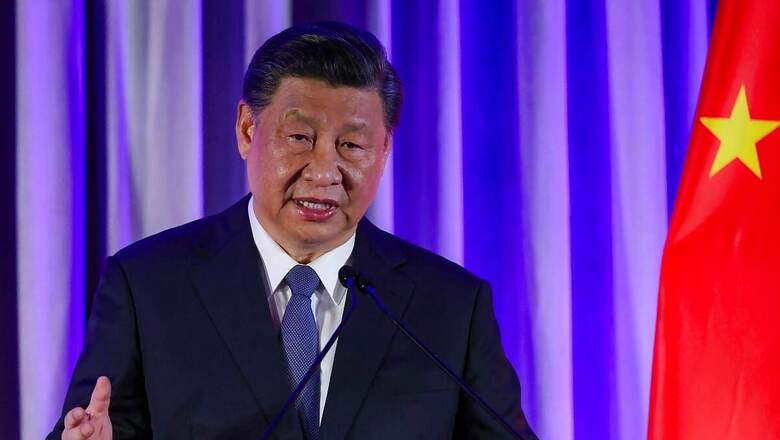Global Watch | PLA Shake-Up Betrays Massive Corruption and Power Struggle in Chinese Power Corridors

views
With over two million military personnel making it the world’s largest army, the Chinese military (otherwise known as People’s Liberation Army or PLA) has encountered a few uncomfortable developments in recent months. The abrupt purging and replacements of top military personnel due to graft and corruption cases came at a time when its military activities in the disputed South China Sea (SCS) turned more ambitious and aggressive lately. Meanwhile, Beijing’s new defence budget (2024) witnessed a stark increase of about 7.2. per cent this year (about $235 billion), this being the third consecutive year. With the obvious prioritisation on defence to reach its goal of transforming PLA into a fully modernised military by 2027, the question arises, how China’s strategy in SCS would unfold in the near future, given the challenges facing its military.
Xi Jinping assumed his leadership with the outlook of ‘zero tolerance’ towards corruption, as noted in his launch of the anti-corruption campaign 11 years back. With Xi vowing to go after “tigers and flies”, that is, high-ranking officials as well as low-level cadres, the prosecutions of senior-level military officials surged since 2013. Since his launch of the campaign, a total of 294 senior officials are believed to have been sacked by the Central Commission for Discipline Inspection (CCDI), China’s top anti-corruption body. In fact, last year saw a 40 per cent rise in investigation cases as compared to the previous year, with 45 senior personnel being investigated (27 of them being retired). Former defence minister Li Shangfu, appointed only in March 2023, disappeared from public view before his removal was formally announced in October without any explanation. Shangfu previously held the position of the Head of China’s Equipment Development Department (CEDD) (2017-2022) where he oversaw arms procurement of the PLA. In September 2023, he, along with eight senior officials, were reported to be placed under investigation on suspected corruption charges of arms procurement.
Soon after the announcement of Shangfu’s removal, nine senior generals of the PLA were also removed without any formal explanation. This included five generals linked to the PLA Rocket Force and two from CEDD. Before their formal removal, these officials were also stripped off their positions in the National People’s Congress, thereby, removing the immunity enjoyed by NPC members from being arrested on criminal charges. The recent purges, however, have been centred around Beijing’s secretive and elite military branch, the PLA Rocket Force (PLARF), revamped by Xi in 2015. PLARF became the PLA’s major component that oversees and controls China’s nuclear weapons and ballistic missiles. Since June 2023, the purges in PLARF, namely, Commander Li Yuchao, Commissar Xu Zhongbo and deputies Li Guangbin and Zhang Zhenzhong, on suspected embezzlement and espionage charges revealed Xi’s anti-corruption goal is far from over. Given the significance of missiles as a crucial military asset in fulfilling Beijing’s ambitions in Taiwan and the South China Sea, the purges of senior military officials reflect the recurring problems of corruption in the Chinese military.
A major goal of Xi’s strict campaign to root out corruption is to ensure greater party control over the military, for the PLA is to serve the political needs of the CCP as well as the country’s global interests. PLA’s party loyalty (to the CCP), is, therefore, a prerequisite to sustain China’s communist regime. However, growing corruption cases in the PLA serve as a major hindrance in its warfare capabilities along with resource drain. The recent purges are centred around equipment issues, fake combat capabilities and deception in the military ranks which inevitably undermine leadership stability in China and Xi’s efforts in modernising the military. These challenges come at a crucial time when Beijing is engaged in tensions with neighbouring countries, especially the Philippines, over the South China Sea dispute.
Amidst the corruption in the PLA, China’s military ambitions seem to continue, with an increasing focus on the South China Sea (SCS), over which it claims to have its sovereignty. China has built the world’s largest naval fleet of more than 340 warships. Its informal military militia is mostly concentrated in the Spratly and Paracel islands of the SCS, indicating China’s growing militarised intention of the dispute. Since last year, Chinese ships were found frequently patrolling in disputed territorial waters of SCS, engaging in harassment and intimidation, including the latest water cannon attacks on Philippine shipping vessels as part of its grey-zone tactics. Last month, the Philippines also accused China of aggressive actions whereby Chinese Coast Guard and Maritime Militia vessels obstructed Manila’s resupply mission.
The recent heightened Chinese naval incursions in SCS led to the first joint military exercises (called Maritime Cooperative Activity) in SCS by the Philippines, Japan, Australia and the US to ensure joint efforts at maritime security and regional cooperation. Coinciding with this, China, too, conducted “combat patrols” the same day. The PLA calls this drill to be “aiming to control any military activities that could escalate tensions in the region”, although not specifying the area of this exercise. According to the Philippines Army, Chinese vessels were sent to the Philippines’ exclusive economic zone in the West Philippines Sea. The PLA, moreover, warned of strengthening wartime preparation to safeguard its sovereignty and peace and stability in the SCS. China now claims to have concluded a “gentleman’s agreement” with former Philippine President Duterte whereby Manilla ‘promised’ to not build structures at Second Thomas Shoal which is controlled by the Philippines. While the present Marcos government in the Philippines calls this to be a secret agreement, China is now pressing the Philippines to remove its ‘illegal’ warships from Second Thomas Shoal over which Beijing has claims to have ‘complete sovereignty’.
China’s approach to SCS has recently turned more militarised, with many predicting an overt military escalation in the near future. For Beijing to realise its SCS ambitions, loyalty, cooperation and effectiveness of the Chinese military is a crucial need more than ever. However, the shakeup in the Chinese military, grappling with recent corruption cases, is essentially not only posing a challenge to Xi’s leadership, but also undermining military capabilities envisioned to reach its goal of modernisation of the military. If the challenges in the PLA continue, the geopolitical dynamics in the SCS dispute may take an escalating turn beyond Xi’s control and would invite more disaster not only for his leadership but also for the perceived capabilities of the world’s largest army.
The writer is an author and columnist and has written several books. His X handle is @ArunAnandLive. Views expressed in the above piece are personal and solely that of the author. They do not necessarily reflect News18’s views.

















Comments
0 comment